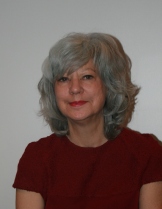JOHN BLAKINGER, Wednesday 26 June 2019, 15:00-16:30 BST
Terra Visiting Professor of American Art, University of Oxford
‘“To Remain Silent is to be Complicit”: Arts Funding in the Trump Era’
MARY ANNE GOLEY, Thursday 27 June 2019, 15:00-16:30 BST
Founding Director of the Fine Arts Program, U.S. Federal Reserve
‘Playing by the Rules, How I Directed the Fine Arts Program of the Federal Reserve Board, 1975 thru 2006’
Read more about our distinguished speakers below.
Click on a name above or visit the Registration page to secure a place.
John Blakinger

In November 2018, a photograph of Honduran migrants fleeing tear gas fired by officers at the US-Mexico border ricocheted across the Internet. The striking photo focused debate on the Trump administration’s immigration policies, but also on a more unlikely topic: arts funding. The tear gas canisters fired at asylum seekers were manufactured by Safariland, a company specializing in the sale of “less-lethal” riot control equipment. Safariland founder and CEO Warren B. Kanders is also a vice chairman of the Board of Trustees at the Whitney Museum of American Art. This unexpected link between the Trump administration and the Whitney prompted demonstrations in the Museum’s lobby. A letter to the Museum’s Director signed by nearly a hundred Whitney employees declared: “to remain silent is to remain complicit.”
What are the ethical, moral, and political implications of private arts funding? This lecture examines protests led by groups like Decolonize This Place and Occupy Museums at the Whitney, the Museum of Modern Art, the Metropolitan Museum of Art, and the American Museum of Natural History. It revises the concept of the culture war for the current moment, revealing how old controversies have emerged in a new form. While the infamous debates of the 1980s and 1990s focused on right-wing opposition to public funding and government support, a new set of controversies instead reflects left-wing opposition to private funding and even specific benefactors. Financing the arts today has created increasingly complex entanglements between museums and the ultra-wealthy, whose political donations and business practices are not always aligned with the mandate of the museum. Immigration, climate change, foreign policy, the opioid crisis: current events that may seem separate from the day-to-day operations of the museum are now intimately linked. The museum is target for new forms of activism.
Biography
John R. Blakinger is the 2018-2019 Terra Foundation Visiting Professor of American Art at the University of Oxford. He studies modern and contemporary art, with a focus on aesthetics and politics. He received his PhD in art history from Stanford University in 2016 and was a two-year predoctoral fellow at the Center for Advanced Study in the Visual Arts (CASVA) at the National Gallery of Art in Washington, DC, and a two-year postdoctoral fellow in the Society of Fellows in the Humanities at the University of Southern California. His book Gyorgy Kepes: Undreaming the Bauhaus is forthcoming from the MIT Press in June 2019; other writings have appeared in Tate Papers, CAA Reviews, Design Issues, and edited volumes. Blakinger is now conceptualizing a new book-length project exploring recent controversies in the arts.
Mary Anne Goley

Mary Anne Goley was the founding Director of the Fine Arts Program of the Federal Reserve Board (1975 through 2006). She led a 15 member Advisory Panel and liaised with Federal Reserve Board Members and the 36 system wide Bank Presidents and their Directors advising on Board art policy. She was responsible for strategic planning and oversight of all administrative and curatorial functions related to the following: 1) organization of public exhibitions including international collaborations with foreign central banks, 2) exhibition catalogues, 3) development of a permanent collection through gifts, 4) loan program from museums and private collectors, and 5) advising and acquiring contemporary art and site specific commissions for Federal Reserve Banks, including Miami, Jacksonville, Dallas, Birmingham, Cleveland, Atlanta, Houston, and Detroit. J. Carter Brown, Director of the National Gallery of Art, wrote of the Fed’s program, “It is a model for others in our field to see someone take a challenge and make so much of it.”
Organizing over 110 exhibitions, the strategy at the Federal Reserve complemented that of local museums while making contributions to the field as for example The Hague School and Its American Legacy (1982), Post Graffiti/Fine Art (1991), The Influence of Velasquez on Modern Painting, the American Experience (2000), and The Face of Contemporary Art in China (2006). Beginning in 1988 Goley worked with central banks and museums in Austria, Greece, Hungary, Israel, Poland, Romania, Spain, Switzerland, and The Netherlands. Two exhibitions resulted in foreign decorations from The Netherlands and Luxembourg. In 2006 a selection of pieces from the Board’s collection was featured at the European Central Bank.
In 1981 Goley was temporarily assigned to the Presidential Task Force on the Arts and Humanities. In 1990, she concluded six years on the Board of the Arlington Arts Center–a regional center for emerging artists – three of them as President. From 1994–1996, Goley served as President of the Association of Professional Art Advisors (APAA), a nationwide standards organization for corporate art advisors. Goley was a member of the Museum Trustee Association (MTA) until 2006. In 2003 she served on a panel for the National Endowment for the Arts’ Save America’s Treasures grant program.
She is an acknowledged expert on the American painters, John W. Alexander and Eduard J. Steichen. She curated Graham Williford’s America (Tyler Museum of Art, Tyler, Texas, 2008).
Publications:
Biography of John White Alexander, An American Artist in the Gilded Age (London: PWP Publishers, 2018).
Selected Articles: Bulletin Musees Royaux des Beaus-Arts de Belgique; Bulletin of the Detroit Institute of Arts; Journal of Industrial Archeology; Wall Street Journal; The Magazine Antiques, Apollo Magazine; Apollo Blog; and Princeton University Library Chronicle.
Press about: New York Times (1982); Wall Street Journal (2004); Vanity Fair (2006), The Art Newspaper (2018); Maine Antique Digest (2018).